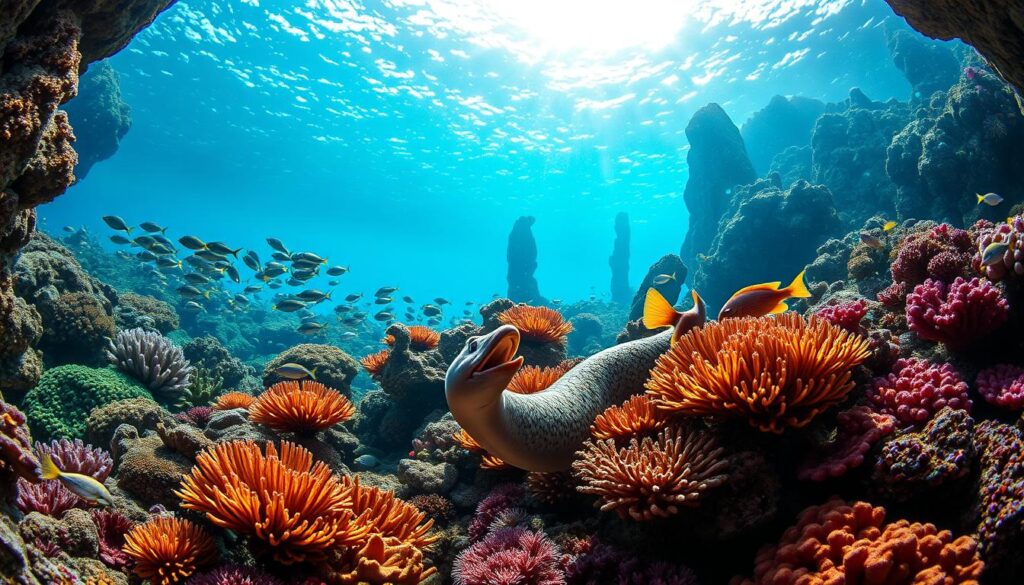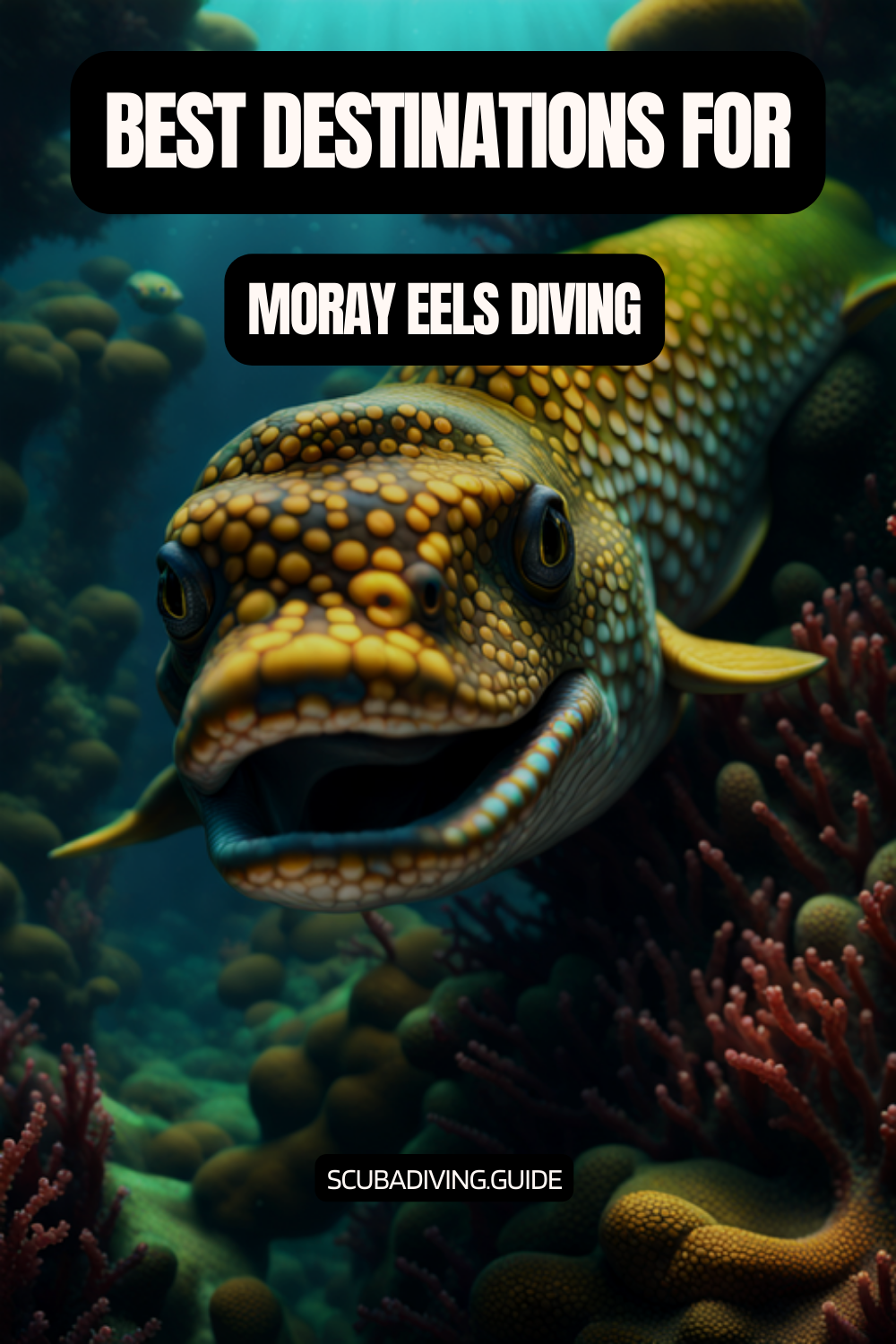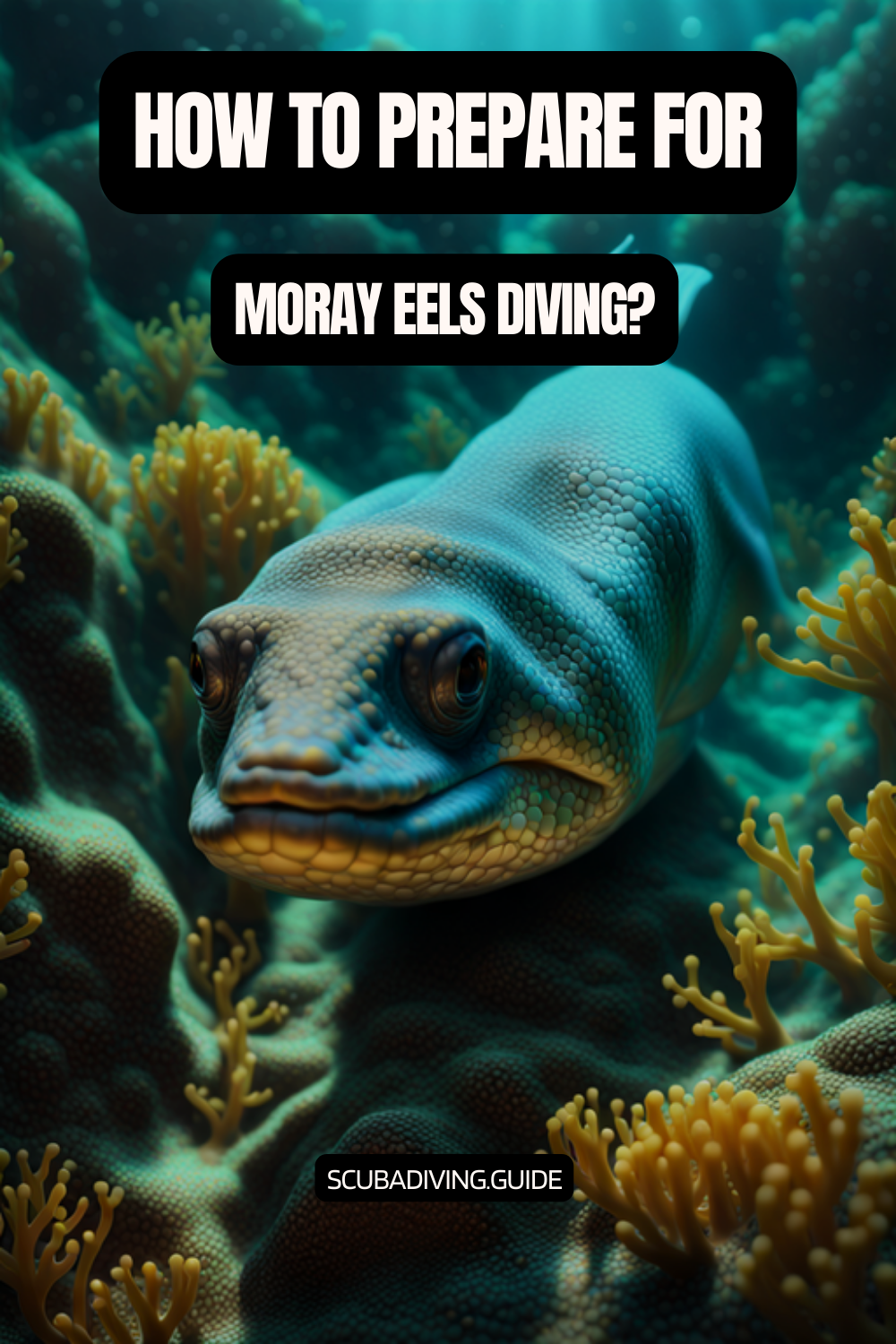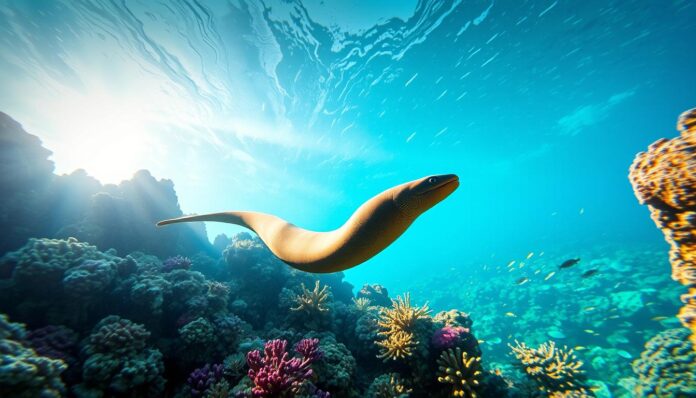Did you know moray eels come in over 200 species? They range from 25 cm to 4 meters long. These amazing sea creatures have fascinated divers for years, making underwater adventures even more exciting.
Scuba diving with moray eels is a unique chance to see a fascinating sea predator. They live in tropical and temperate seas, hiding in coral reefs and rocky areas. Divers looking for an underwater adventure will find them thrilling.
Moray eels have a special jaw and bright colors, showing off marine life’s diversity. Their night habits and complex actions make them a favorite among divers who love marine life.
Key Takeaways – Diving with Moray Eels
- Discover over 200 unique moray eel species worldwide
- Explore diverse marine habitats from tropical to temperate seas
- Learn essential safety techniques for underwater encounters
- Understand moray eel behavior and characteristics
- Prepare for an unforgettable scuba diving experience
Introduction to Moray Eels
Diving into the world of marine life encounters reveals the extraordinary realm of moray eels. These mysterious creatures captivate underwater explorers. They live in tropical and subtropical waters, giving divers a chance to see their fascinating behavior.
What are Moray Eels?
Moray eels are a diverse group of marine predators with about 200 different species worldwide. They have a unique elongated body and strong jaw. This makes them stand out in marine ecosystems.
- Average length: 2 to 10 feet
- Maximum possible length: Up to 13 feet
- Bite force: Approximately 200 PSI
Habitats of Moray Eels
These fascinating creatures live mainly in coral reefs, rocky crevices, and tropical marine environments. Their adaptability lets them thrive in different underwater landscapes.
| Species | Depth Range | Max Length |
|---|---|---|
| Whitemouth Moray | 1-36 meters | 1.2 meters |
| Zebra Moray | Up to 39 meters | 1.5 meters |
| Canary Moray | 17-605 meters | 35 cm |
Behavior and Characteristics
Moray eels have complex marine life encounters. They hunt strategically and defend their territory. Their aggressive appearance often hides a more nuanced behavior.
“Moray eels are masters of camouflage, blending seamlessly into their underwater environments.” – Marine Biology Research Institute
It’s important to understand their behavior for safe diving. They prefer water temperatures between 68°F and 85°F. This makes tropical reefs their perfect home.
Safety Considerations When Diving
Diving with moray eels needs a good grasp of marine life and safety. These creatures are often seen wrongly, but with the right knowledge, divers can have safe and fun times.
Understanding Moray Eel Behavior
Moray eels are not usually aggressive, but they will fight back if scared. Their ways of talking can be tricky for divers who don’t get it. Here are some important things to know:
- Open-mouthed “gaping” is often a way they breathe, not a sign of anger
- Moray eels mostly hunt at twilight
- They can’t see well and mostly use their smell
Essential Safety Equipment
Being ready is key for eco-tourism. Divers should bring:
| Safety Equipment | Purpose |
|---|---|
| Thick wetsuit | Protection from possible bites |
| Long gloves | More protection for your hands |
| Underwater communication device | For signaling any dangers |
Tips for a Safe Dive Experience
To have a safe time with moray eels, divers should:
- Keep a safe distance
- Avoid sudden moves
- Never try to feed them by hand
- Stay calm and move slowly
Remember: Observation is key to safe and responsible marine interactions.
By following these safety tips, divers can lower risks and have amazing times with these incredible sea creatures.
Best Destinations for Diving with Moray Eels
Diving with moray eels is an exciting adventure. With over 200 species worldwide, they live in many marine environments. This makes them a great sight for divers in different places.

For those looking to see Moray Eels in their natural home, there are amazing places to visit. These spots let you see these incredible creatures up close.
- Asia:
- Maldives: The Maldives is renowned for its vibrant coral reefs and diverse marine life, including several species of moray eels. The Ari Atoll and North Malé Atoll are popular dive spots for encountering these fascinating creatures.
- Indonesia: The rich biodiversity of Indonesian waters offers excellent opportunities to dive with moray eels. Destinations like Raja Ampat, Komodo National Park, and Bunaken Marine Park are known for their healthy coral reefs and thriving moray eel populations.
- Africa:
- Egypt: The Red Sea in Egypt is home to a wide variety of marine life, including moray eels. Destinations such as Sharm El Sheikh and Dahab are known for their stunning dive sites and the chance to encounter different species of moray eels.
- Caribbean:
- Bonaire: Bonaire in the Dutch Caribbean is famous for its pristine marine environment. Its protected reefs offer abundant opportunities to encounter moray eels, with popular dive sites including the Salt Pier and the Hilma Hooker wreck.
- Cayman Islands: The Cayman Islands boast crystal-clear waters and spectacular dive sites. Locations like Bloody Bay Wall in Little Cayman and the USS Kittiwake wreck in Grand Cayman are known for their thriving moray eel populations.
- Central America:
- Belize: Belize’s Barrier Reef, a UNESCO World Heritage site, is teeming with marine life, including moray eels. Diving spots like the Blue Hole, Lighthouse Reef, and Hol Chan Marine Reserve offer the chance to dive alongside these fascinating creatures.
- Costa Rica: The rich Pacific and Caribbean coastlines of Costa Rica provide ample opportunities for encounters with moray eels. Locations like Cocos Island and Cano Island Biological Reserve are known for their diverse marine ecosystems.
- Europe:
- Greece: The Greek islands offer unique diving experiences, and certain locations such as Zakynthos, Rhodes, and Crete provide opportunities to observe Mediterranean moray eels in their natural habitat.
- Canary Islands: The volcanic landscapes surrounding the Canary Islands in Spain provide a captivating backdrop for diving with moray eels. Lanzarote and Tenerife are popular destinations where these intriguing creatures can be encountered.
- Oceania:
- Australia: The Great Barrier Reef, one of the world’s most iconic dive destinations, is home to an abundance of marine life, including moray eels. Other locations such as the Ningaloo Reef in Western Australia and the Coral Sea offer thrilling encounters with these creatures.
- Fiji: Fiji’s vibrant reefs and clear waters provide a haven for moray eels. The Bligh Water, Taveuni Island, and the Great Astrolabe Reef are known for their diverse marine ecosystems and encounters with these captivating creatures.
- North America:
- Florida, USA: Florida’s warm waters attract an array of marine life, including moray eels. The Florida Keys, with its renowned dive sites like Molasses Reef and Looe Key, offer opportunities to dive alongside these fascinating creatures.
- Mexico: Mexico’s Riviera Maya, including popular dive destinations like Cozumel and the cenotes of the Yucatan Peninsula, offers encounters with various species of moray eels.
- South America:
- Galapagos Islands, Ecuador: The Galapagos Islands, famous for their unique wildlife, also provide opportunities to dive with moray eels. Exploring the underwater wonders of sites like Darwin and Wolf Islands offers the chance to witness these captivating creatures in their natural habitat.
These destinations offer incredible diving experiences where encounters with moray eels can be enjoyed. However, it’s important to research local regulations, consult with dive operators, and dive responsibly to ensure the preservation of these fragile ecosystems.
In conclusion, diving with moray eels in these diverse regions allows you to explore the wonders of the underwater world and witness the captivating behavior of these creatures. Each destination offers its own unique charm and unforgettable encounters, making it a thrilling experience for divers of all levels.

Unique Locations to Explore
For the brave divers, here are some special places to dive:
| Location | Unique Feature | Moray Eel Species |
|---|---|---|
| Fiji | Pristine coral reefs | Giant Moray |
| Indonesia | Diverse marine ecosystems | Zebra Moray |
| Maldives | Crystal clear waters | White-eye Moray |
“Diving with moray eels is like entering a hidden world of marine mystery and wonder.” – Marine Exploration Magazine
Every place offers unique opportunities to see these amazing creatures. They promise unforgettable dives for all who love the sea.
Planning Your Dive Trip
Exploring underwater with moray eels needs careful planning. Scuba diving with them is an exciting adventure for those who love the sea. It’s a chance to see unique creatures up close.

Best Times for Diving
Night diving is the best time to see moray eels. They are most active at night. They come out of their hiding spots in coral reefs and rocky areas.
- Ideal diving times: 9 PM – midnight
- Peak seasons: Late spring to early fall
- Water temperature ranges: 75-85°F
Necessary Certifications and Training
Getting professional dive certifications is key for safe diving with moray eels. Here are some recommended levels:
- Open Water Certification
- Advanced Open Water Diver
- Specialty Night Diving Certification
Choosing the Right Dive Operator
Picking an experienced dive operator can make your moray eel diving trip better. Look for these important factors:
| Criteria | Recommended Attributes |
|---|---|
| Experience | Minimum 5 years in marine expeditions |
| Safety Record | Proven track record of safe diving practices |
| Local Knowledge | Expertise in specific moray eel habitats |
“The success of your dive depends not just on luck, but on meticulous preparation and choosing the right guide.”
Gear Recommendations for Eel Encounters
Exploring underwater is exciting, but it needs careful planning. When you meet creatures like moray eels, the right scuba gear is key. It can turn a simple dive into an amazing adventure.
Diving with moray eels requires special gear for safety and fun. The right equipment can greatly improve your underwater journey.
Essential Scuba Gear for Marine Encounters
- Thick neoprene wetsuit for thermal protection
- Reinforced diving gloves to prevent accidental scratches
- High-powered dive light for exploring reef crevices
- Durable mask with wide peripheral vision
Recommended Camera Equipment
Photographing moray eels needs special underwater photography gear. Here are some tips:
- Waterproof digital camera with macro lens
- External strobe lights for clear underwater images
- Camera housing rated for deep-water exploration
Accessories for Enhanced Experience
Professional divers know that the right accessories can elevate underwater exploration. Here are some extra items to consider:
- Underwater communication slate
- Marine life identification guide
- Compact underwater GPS device
“The right gear transforms observation into connection with marine life.”
There are about 200 species of moray eels worldwide. Each dive is unique. Your scuba gear should be ready for any marine encounter while protecting the ocean.
Diving Techniques for Moray Eel Sightings
Exploring the underwater world of moray eels needs careful preparation and respect. There are about 200 species of moray eels worldwide. Divers get to see these fascinating creatures in their natural home.

When diving with these marine predators, safety is key. Knowing their behavior helps make safe and memorable dives.
Approaching Moray Eels Safely
Here are important tips for meeting moray eels:
- Move slowly and deliberately to avoid startling the eel
- Maintain neutral buoyancy and minimize sudden movements
- Use indirect approaches to observe without threatening the eel
- Wear protective diving gear to prevent accidental contact
Photography Tips While Diving
Getting great moray eel photos takes patience and skill:
- Use wide-angle or macro lenses depending on eel size
- Choose low-light camera settings for night dive photography
- Position yourself carefully without disturbing the marine environment
- Wait for natural eel behaviors to create compelling shots
Maintaining a Respectful Distance
Responsible diving means protecting marine life. Keep at least 3-4 feet away from moray eels for safety. These creatures are not aggressive but will defend themselves if threatened.
“Observe, respect, and appreciate the underwater world without interference.” – Marine Biology Expert
Understanding Moray Eel Ecology
Diving into the world of moray eels shows us a complex marine ecosystem. These creatures play a key role in reef environments around the world. Their behavior and importance make them essential to these ecosystems.
Role in Marine Ecosystems
Moray eels are important predators in coral reefs. Studies on 67 reefs in 12 Caribbean countries show their vital role. They have unique ways of living in these environments.
- Reef complexity affects moray eel numbers
- They thrive where sharks are less common
- There are about 200 species worldwide
Diet and Feeding Habits
Moray eels have clever hunting ways. They hunt at night using their great sense of smell. They catch:
- Fish
- Crabs
- Shrimp
- Octopuses
- Squid
Their special jaws let them eat bigger prey, helping them succeed in hunting.
Conservation Concerns
Protecting moray eels is important, and eco-tourism helps a lot. Climate change and more fishing are big threats. Divers can help by:
- Causing less disturbance underwater
- Supporting marine conservation
- Telling authorities about illegal fishing
Learning about moray eel ecology helps us value these amazing sea creatures. It also shows us how important they are to their ecosystems.
Frequently Asked Questions About Moray Eels
Divers often wonder about moray eels, those amazing creatures found in coral reefs and rocky areas underwater. Knowing how moray eels behave is key to safe and respectful diving.
Are Moray Eels Dangerous?
Moray eels get a bad rap, but most are not a big threat to humans. With over 200 species worldwide, only a few are aggressive. Taking the right diving safety steps can lower risks.
- Rarely attack unprovoked
- Defensive when feeling threatened
- Most interactions are passive
How Close Can You Get to Moray Eels?
It’s important to keep a safe distance from moray eels. Divers should stay at least 3-4 feet away. This helps avoid any defensive actions from the eels.
“Observe, but do not disturb” is the golden rule of underwater exploration.
What to Do If You See an Eel?
If you see a moray eel while diving, follow these safety tips:
- Remain calm and stay very quiet
- Move slowly and carefully
- Avoid looking them straight in the eye
- Never try to touch or feed them
Remember, most moray eel species are more interested in avoiding confrontation than engaging with divers.
Common Marine Species Found Alongside Moray Eels
Diving with moray eels offers the opportunity to encounter a variety of marine species that share their habitat. Exploring the underwater world alongside these captivating creatures allows divers to witness the interconnectedness and biodiversity of marine ecosystems. Here are some common marine species often found alongside moray eels:
- Cleaner Fish: Cleaner fish, such as cleaner wrasses and cleaner gobies, play a vital role in maintaining the health of marine life. They establish cleaning stations where they remove parasites and dead skin from the bodies of larger fish, including moray eels. Observing the interaction between cleaner fish and moray eels is a fascinating sight, showcasing the symbiotic relationships that exist within the underwater ecosystem.
- Reef Fish: Moray eels share their habitat with a diverse array of reef fish. Colorful species like angelfish, butterflyfish, and damselfish can be found swimming around coral formations, adding vibrancy to the underwater scenery. These fish rely on the reef for food and shelter, forming an integral part of the complex web of life within the coral ecosystem.
- Crustaceans: Alongside moray eels, various crustaceans can be observed scuttling across the reef. Hermit crabs, shrimp, and lobsters often find refuge within crevices and coral structures. Their presence contributes to the overall biodiversity and adds a sense of intrigue to the underwater landscape.
- Octopuses: Another fascinating species that shares the habitat with moray eels is the octopus. These intelligent creatures are masters of disguise, blending seamlessly with their surroundings. Observing an octopus maneuvering through the reef and displaying its unique behaviors is a remarkable experience that further enriches the dive.
- Sea Turtles: In some areas, divers may be fortunate enough to encounter sea turtles alongside moray eels. These graceful creatures gracefully glide through the water, symbolizing the beauty and fragility of marine life. Swimming alongside a sea turtle while observing a moray eel in its habitat creates a truly awe-inspiring experience.
- Rays and Sharks: In certain regions, divers may have the chance to encounter rays, such as eagle rays or stingrays, as well as smaller species of sharks, like reef sharks. These magnificent creatures add an element of excitement and wonder to the dive. Witnessing their effortless movements and observing their behavior in close proximity to moray eels creates a truly memorable underwater encounter.
- Coral and Invertebrates: Coral reefs are home to a myriad of colorful corals and fascinating invertebrates. Soft corals, hard corals, sea fans, and sponges create a vibrant and intricate underwater ecosystem. Exploring the reef alongside moray eels reveals the delicate balance between these organisms and the essential role they play in supporting marine life.
Encountering these common marine species alongside moray eels provides a holistic perspective of the interconnectedness and biodiversity of the underwater world. Each species contributes to the delicate balance of the ecosystem, underscoring the importance of preserving these habitats for future generations.
Conclusion: Your Ultimate Dive Adventure
Scuba diving with moray eels is an amazing underwater adventure. It mixes excitement, learning, and caring for the ocean. These creatures show us a world full of wonder, beyond their first scary look.
Exploring moray eels needs careful planning, respect for the sea, and safety. Even though they might look scary, most are not mean if we keep our distance. By diving responsibly, we can have safe and amazing times with these creatures.
Dive Into Discovery
Your dive with moray eels is more than fun. It’s a chance to connect with sea life, help protect it, and learn about these amazing animals. The Monterey Bay Aquarium’s studies show how important moray eels are to our oceans.
Take Action
We encourage divers to keep exploring, learning, and sharing their stories. Get professional training, support ocean conservation, and tell others about moray eels. Your efforts to dive responsibly can really help protect these incredible sea creatures.
FAQ – Diving with Moray Eels
Are Moray Eels Dangerous to Divers?
Moray eels are not usually aggressive towards humans. They might bite if they feel scared. Most of the time, divers can safely watch them from a distance.
Their mouths open wide is just how they breathe. It’s not a sign they want to fight. Always be careful and don’t touch them.
How Close Can I Get to a Moray Eel While Diving?
Keep at least 3-4 feet away from moray eels. Never try to touch or feed them. Move slowly and don’t stare, as it might scare them.
Experts say it’s best to watch them from a safe distance. This keeps both the diver and the eel safe.
What Should I Do If a Moray Eel Approaches Me?
Stay calm and don’t move too fast. Quick actions can scare the eel. If you need to back away, do it slowly.
Most moray eels are curious but not mean. If you’re taking pictures, stay calm and keep observing without sudden moves.
Do All Moray Eels Look the Same?
No, there are over 200 types of moray eels. They vary in size, color, and pattern. Some, like the Green Moray, stand out.
They range from 1 foot to 10 feet long. Each is adapted to its own marine home.
What Equipment Do I Need for Moray Eel Diving?
You’ll need a good wetsuit, dive mask, and fins. An underwater camera and dive light are also key. Special gloves and a dive slate can help too.
Make sure your gear is in top shape. It should fit the diving conditions you’ll face.
Where Are the Best Locations to See Moray Eels?
Great places include the Caribbean, Red Sea, and Indo-Pacific. The Cayman Islands, Egypt’s Red Sea, and Indonesia are top spots. Each place has its own unique marine life.
Are Night Dives Better for Moray Eel Encounters?
Night dives can be better for seeing moray eels in action. They hunt more at night. But, you need proper training and the right gear for a safe dive.
How Can I Photograph Moray Eels Safely?
Use a camera that works well in low light and a wide-angle lens. Move slowly and avoid sudden flashes. Position yourself carefully to not disturb the eel.
Remember, the eel’s comfort is more important than getting the perfect photo. Always respect marine life first.
